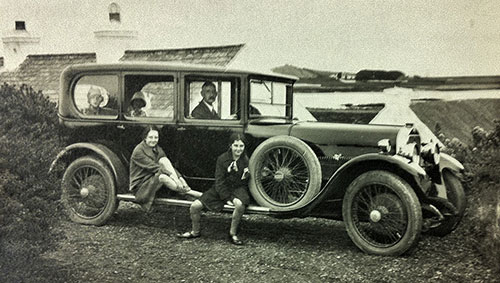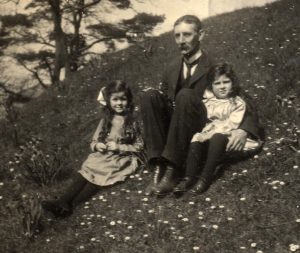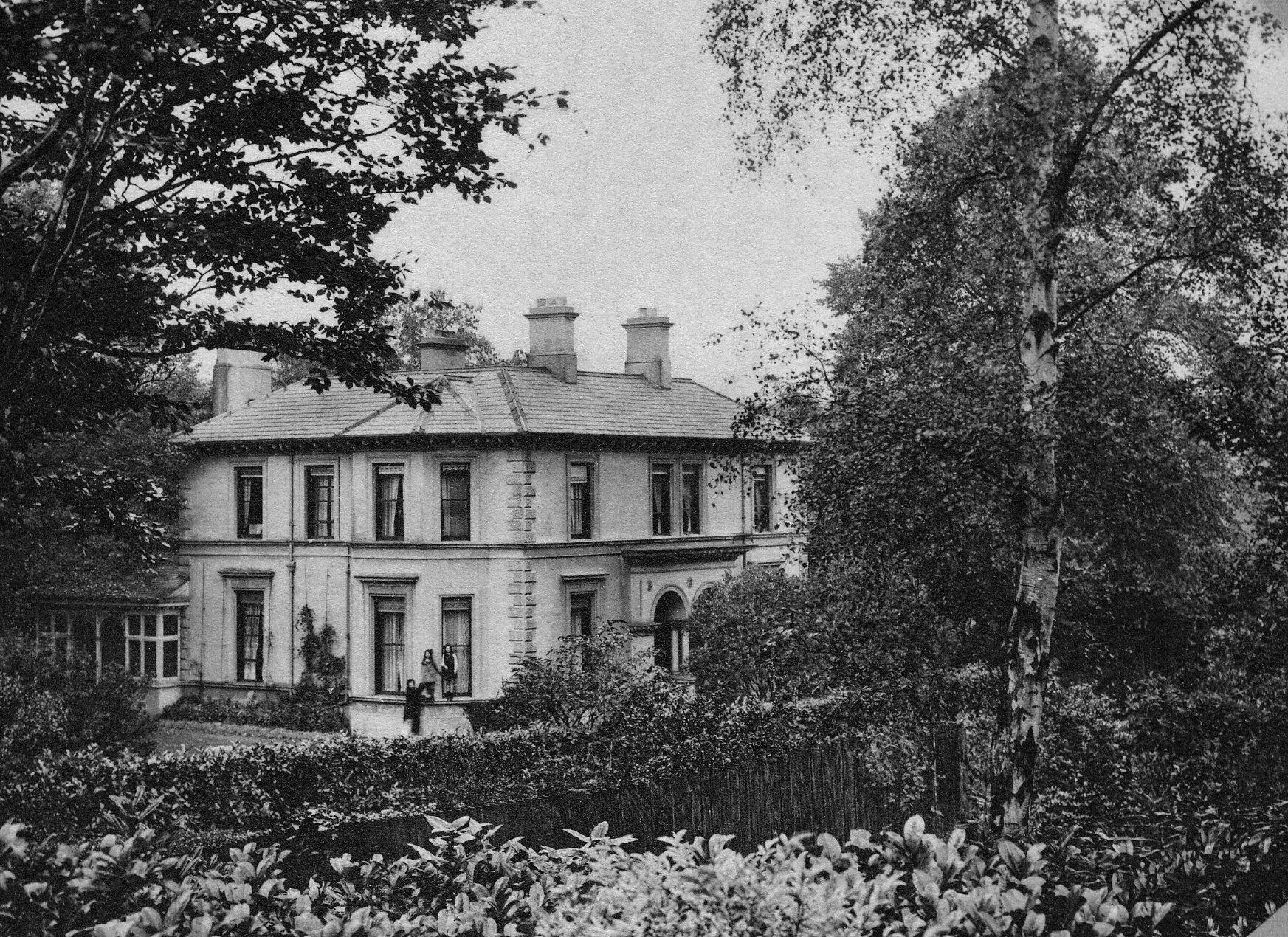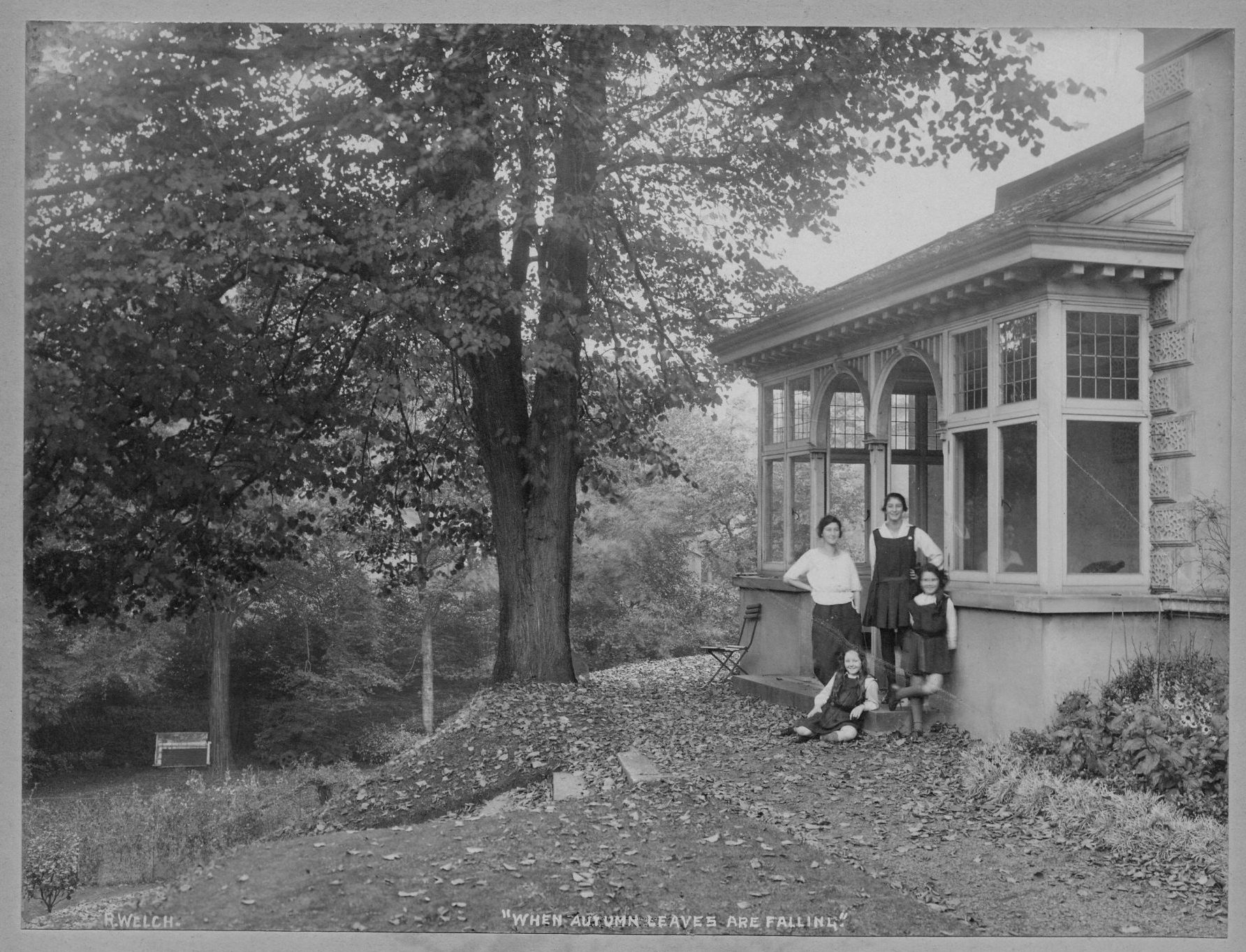Sarah Watkinson
My clearest memory of my Loewenthal grandfather is of his bending down to my level from his armchair, to feel if there was enough room for my toes in my new slippers. I was three, in my place on the hearthrug beside the black dog Hamlet. In my toddler memory from 76 years ago, this was the centre of the house, a completely happy place next to Bampa’s feet in shiny black shoes and legs in dark trousers. Peat smouldered in the hearth under its massive fossiliferous black marble surround, the scent mingling with his cigar smoke. Perhaps a clock ticked. The drawing room stretched darkly behind us, divided in two by a vast velvet curtain. The ceiling was out of sight and I sometimes found it agreeable to sit under the grand piano; whenever I hear Kinderszenen now, a strong memory of Lennoxvale comes back; my mother Joan told me that her friend Elizabeth Kinnaird’s boyfriend might have played it as I sat beneath.
Next to the drawing-room, and also opening off the square hall, was the sunny dining room where I had FruGrains for breakfast, alone with Joany at a long shiny table; a memory of this room is strongly triggered by the smaller dining room at the Reform Club in London, which at lunchtime has the same smell of last night’s good dinner, cigar smoke and red Turkey carpet. The red carpet with its blue and green lozenge pattern also covered the stairs and the landing where Big Sarah, the maid, gave me rides on the carpet sweeper. You could look down from the bannisters around the landing into the hall below and watch people from on top. In the higher regions of the house I had my cot where I spent ages looking at the ceiling with its crack in the plaster, although once, intolerably bored, I danced in the cot with my doll and crashed through its base onto the floor. Another little room up here was the sewing room, with a ragbag of old petticoats you could dress up in – I never saw anybody sewing in there.
It was as if I could go anywhere and come across people who might, like Big Sarah, find me delightful, or be less responsive – like Margaret the other maid, who inhabited the kitchen. Then it was better to go out into the garden, where Colin the gardener would be busy but friendly among the vegetables and fruit trees, and where a peach tree grew against the house wall. Once there was a single peach in the net hung to catch the fruit, and I was told it was Bampa’s – the only thing I remembered ever having been denied to me in that Arcadian household. A veranda stretched along another side of the house. There were lawns, under big trees alongside the drive, and a copper beech towards the back of the house with a rope swing suspended from a high branch. Round the left side of the house from the drive, a grassy slope made a good place to roll down (perhaps the one on which JMcC and his youngest daughters were photographed; see below). Somebody once made me a snowman there, which Hamlet came and peed on, making a terrible yellow stain.
On my third birthday – February 1945 – Joany stuck red and yellow whirligigs into the grass to spin in the wind and brought in crocuses – purple and gold – arranged in a bowl of sand so that they opened in the warmth of the dining room. All for me! But with hindsight, I wonder if her relief at the prospect of the war ending, and my father Tom’s expected return, contributed to the atmosphere of pure happiness that day, which is one of my strongest memories of Lennoxvale. It was a house full of delight in life; its comfortable security felt proof against what I understood was a dangerous and uncertain world outside.
Oxford, November 2021
Robert Boyd
Yes indeed. Hamlet – though loved, he had halitosis, my first unpleasant breath experience; I think of him whenever I add garlic. Despite this, I, too, liked being on Hamlet’s level. Cigars yes; I think of Bampa (allegedly named because toddler eldest-grandchild John couldn’t say Grandpa) on the now rare occasions the smoke of one comes my way. The dining room too, on whose shiny, and enormous, table napkin rings rolled so enticingly to the irritation of my father, and the grassy slope to roll down round the corner from the veranda. Between rolls, Bampa showed me how he dug out dandelions from the slope with a special knife.
Four years older than cousin Sarah, there were additional excitements. The curving bannisters were a joy to slide down – until I fell the wrong side and landed on my head on the tiles of the Palladian hall round which they ran. I had learnt from someone, probably older brother John, that damaged horses were shot. “Shoot me it’s worse than a bomb” was, once I had stopped crying, my war-time response to the fall.
Later, after peace had come, John and I stayed at Lennoxvale with Amélie who was recuperating from Jaundice. Learning bridge with Bampa was a high spot. So was Margaret’s delicious food – no meat rationing in Northern Ireland. So was a side trip I had to stay with a Kinnaird brother in Carrowdore Castle. Earlier-generation Kinnairds are a feature of the letters (this was George Young Kinnaird’s son, George Young Kinnaird Jr, who owned Carrowdore Castle, see the Index to People).
Later still, John and I went without Amélie. Bampa was, by then, restricted to his upstairs sitting room but the household had its comforting sense of permanency. We played endless monopoly with the Ashby boys in the Vice-chancellor’s residence across the way and, to (Big) Sarah’s outrage, squirted our water pistols there. We didn’t dare in Sarah’s domain. Margaret served our meals in the dining room. Lennoxvale friends entertained us – Elizabeth Kinnaird, Dorothea McDowell, or Nascio Llubera. Supportive loyalty to our grandfather and his daughters I suppose.
Not long before his death, I went on my own, a memorable visit. From Sarah’s “Good morning Master Robert” when she raised the blind and placed tea by my bed (I was 12) until bedtime it was a delightful grown-up experience. A purse had been bought for me. In it, a half-crown was “to spend as you like”. I beat Dorothea at Canasta – to her annoyance. I sat on the floor beside Bampa’s armchair (which I still have) and gained praise by solving a crossword clue for him with the help of his encyclopaedia. I walked round to Elizabeth’s house. I also explored Lennoxvale’s downstairs at my leisure. In my possession as I write is a particularly lovely pack of cards I found in a drawer and surreptitiously purloined; sorry Bampa!
Many decades later three grandchildren returned to Lennoxvale. We were to Rathlin Island to scatter Peggy’s ashes, his centenarian daughter and Hamlet’s owner. No 7 was now University offices. Trees on the slope had overgrown the dandelions of memory. Half as old as these letters, they were already as high as the house. But, for me too, memories of John McCaldin Loewenthal, and of the house to which he directed his letters, trump, indeed, the flow of time.
Tiree, November 2021




Robert John Welch (b 22nd July 1859, d 28th September 1936) was the leading photographer in the north of Ireland at the time. He specialised in outdoors photography and took thousands of photographs of the towns and scenery of Ireland, as well as industrial scenes such as the construction of RMS “Olympic” and “Titanic” at the Harland and Wolff shipyards: https://en.wikipedia.org/wiki/Robert_Welch_(photographer).
